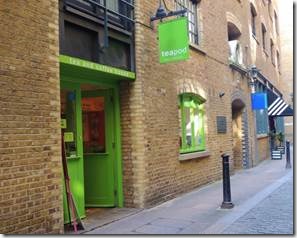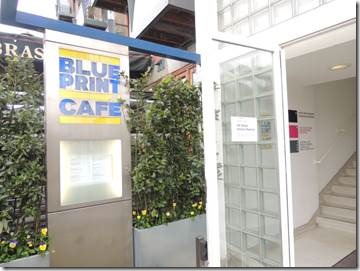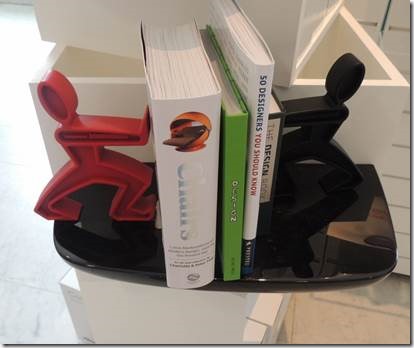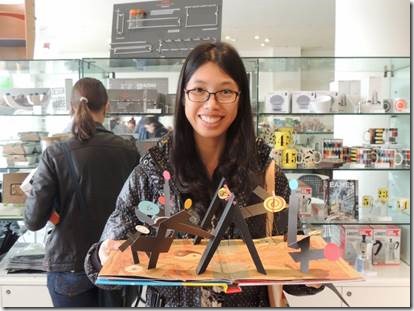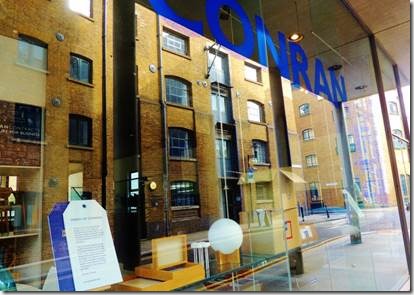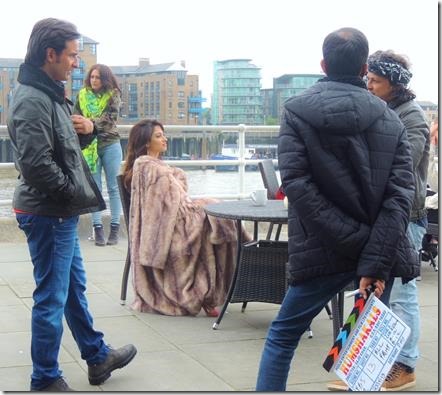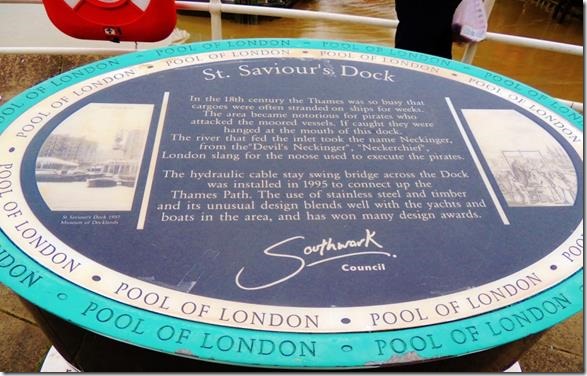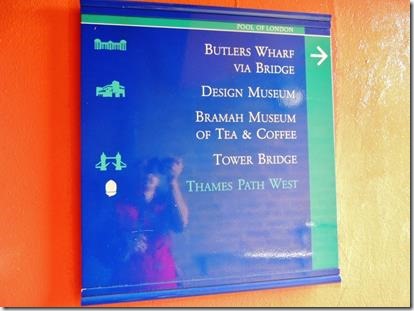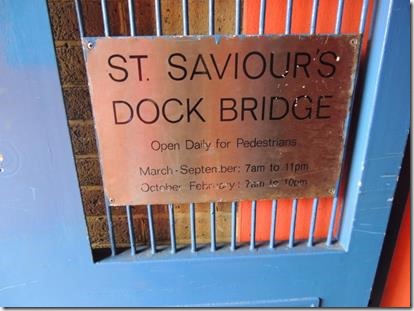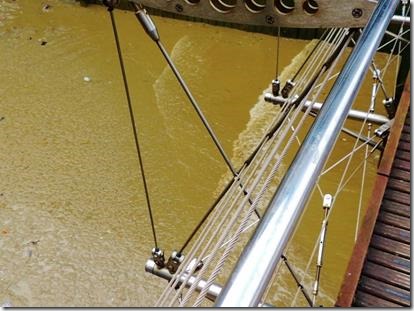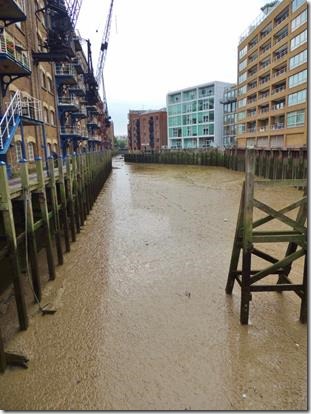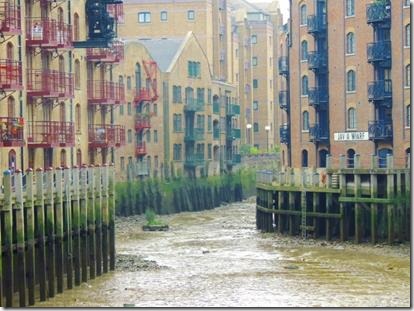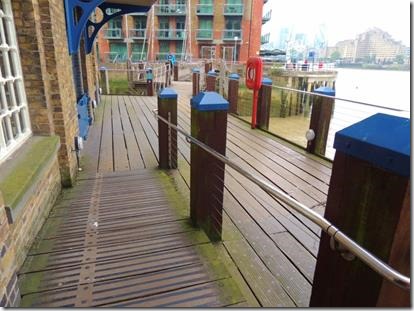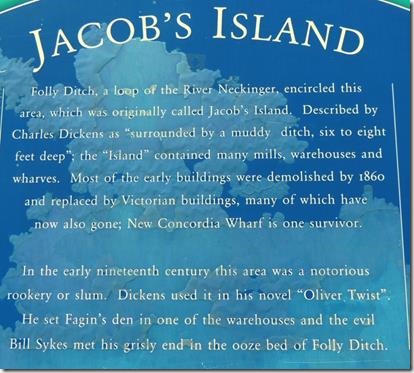Cheers,
We’re mostly packed up and ready to go; our flight home tomorrow. We’ll set out tomorrow at noon; our flight is 4ish, the tube trip about an hour. Our pals Sue and Ed scouted out the best route to Tower Hill Tube station with the fewest steps. As we can each bring a 50 lb suitcase, it’s an opportune time to carry home the two wool carpets we bought in Turkey from the carpet ladies. We might actually have more company this winter so we need to clear off the space in the front cabin. Other stuff will go to Oxfam and other charities when we come back.
While Singkey was here we decided to visit the Tea Pot for a traditional British tea. (Not only a drink but a small meal.) From the Tea Pot we walked to the Design Museum, also on Shad Thames and then along the river to Rotherhithe where we ate lunch at the Ship Pub. Lots of interesting bits to see along the way; too many for even this second “wharf” email.
This email takes us back to London of Dickens but also to today, the time of designer Terence Conran.
Ru
|
Our first stop, the Tea Pot for scones, clotted cream and tea! Singkey, Sue and Randal, Ed was also taking photos. Stretched out panorama of the tea shop with the 4 minute green clock. Your tea is brought to the table and you’re told to watch the clock. Only after 4 minutes should you drink it. Does it work? I actually hadn’t heard the waitress so was unsure when my 4 minutes began. But now that I’ve a small tea pot on the boat, I do wait longer before I actually pour the tea. Interestingly, the shop uses tea bags rather than loose tea. |
|
http://designmuseum.org/ founded by among others, Terence Conran We stopped in to look at the Design Museum museum shop. Lots of interesting things. |
|
“Human” book ends but they do take up shelf space |
|
Pop-up books. |
|
On my later wharf walk I came across Conran Designs totally new to me. |
|
Mass production doesn’t have to = ugly. |
|
Not such a new idea really : I ’ll have to look at Penney. Hopefully they’ve changed the stores back to what they once were. The new layout was awful. I once read something that said mass production introduced ugliness because prior to that, each hand-made product met the specific needs of an individual. Mass produced goods met no individual needs; individuals had to adapt to the product, no matter its color, shape or design. Today, because people are encouraged to want lots of stuff, only mass produced products are affordable. And today, most work/life styles don’t match with wardrobes of expensive clothes or handcrafted everyday household items. I’m certainly not careful enough with stuff though I now think “ fewer and better” because “more” takes up too much space. |
|
This is an abstract from : The Atlantic Monthly | August 1927 ……….”Up to the beginning of the great industrial era of machine-made things, mass production, nation-wide distribution and advertising, most of the implements and furniture with which we performed the act of living were made by hand, and things made by hand unconsciously acquire a certain element of beauty. Consider how satisfying are the shapes of some of these old things—a coach, for instance, or a spinet; a sickle or a ladle. The humblest utensils of our grandfathers are preserved in museums to-day, partly, of course, for the historic associations, but mainly because they have a certain charm. And gradually all that charm vanished. The hand worker who controlled every step of the thing he was making was replaced by a machine minder who had nothing to do with the design. The directing minds, absorbed in the new wonder of so many things made so easily, ignored the fact that it was just as easy for a machine to stamp or print a good pattern as a bad one, and by some perversity nearly always chose the bad one, and aggravated that fact by producing the bad design in incredible quantities. The public, tickled to get so many things so cheaply, accepted them without question, and thus, we had a depressing period when, in New York City, brownstone houses were built literally by the mile, and country houses were of two stories, mansard roof, and cupola, with cast-iron dogs and deer on the lawns, and furnished with horsehair sofas, flowered Brussels carpets, gilt-embossed wall paper, and ormolu clocks under glass bells on the mantelpieces above imitation fireplaces. We passed from the hand to the machine, we enjoyed our era of the triumph of the machine, we acquired wealth, and with wealth education, travel, sophistication, a sense of beauty; and then we began to miss something in our cheap but ugly products. Efficiency was not enough. The machine did not satisfy the soul. Man could not live by bread alone. And thus it came about that beauty, or what one conceived as beauty, became a factor in the production and marketing of goods. http://www.theatlantic.com/past/docs/issues/27aug/calkins.htm |
|
A commercial for was being filmed. No issues with fur in this neighborhood, once the poorest of the poor! |
|
The River Neckinger The Neckinger is one of the ‘lost’ rivers of London which now runs entirely underground, probably merging into the present drain or sewer systems. It rises in Southwark and originally entered the Thames at the tidal inlet now called St Saviour’s Dock ("Savory Dock" on older maps). The river is believed to have got its name from the term "Devil’s neckcloth", a hangman’s noose. Until the 18th century, Thames pirates were executed at Neckinger Wharf, near the mouth of the inlet. The corpses were placed on display as a deterrent further downstream on the Thames. St Saviour’s Dock was created in the 13th century by the Cluniac monks of Bermondsey Abbey (founded 1082, ¾ mile to the south-west, Figs 7 and 8) who enlarged and embanked the inlet, naming the dock after the abbey’s patron, and built and ran a windmill on its East bank, The Mill of St Saviour. Around 1536 (after the dissolution of the monasteries) the windmill was converted into a water mill and "water machine" to supply local inhabitants with water. It later became the first gunpowder factory in England to be powered by water, and later still it was rebuilt as a paper mill, becoming one of the first mills in England to make paper from straw. By Dickens’ time, lead mills occupied the site. It was a tidal mill, and the flow of water was two-way. At 12-hourly high tides (the Thames could rise as much as 12′ at this point) water, controlled by slice gates, flowed into the mill pond south of the mill. The sluices were closed and re-opened at low tide to allow the water to flow out again via the mill races and drive the mill wheels. http://www.hsomerville.com/meccano/Articles/JacobsIsland.htm |
|
Jacob’s Island : "The Venice of Drains", "The Capital of Cholera" and "The Jessore of England". It first came to fame when immortalized as the location of Bill Sikes’ last refuge in "Oliver Twist". Dickens wrote, in 1837: "Near to that part of the Thames on which the church at Rotherhithe abuts, where the buildings on the banks are dirtiest and the vessels on the river blackest with the dust of colliers and the smoke of close-built low-roofed houses, there exists the filthiest, the strangest, the most extraordinary of the many localities that are hidden in London, wholly unknown, even by name, to the great mass of its inhabitants. ‘Beyond Dockhead, in the Borough of Southwark, stands Jacob’s Island, surrounded by a muddy ditch, six or eight feet deep and fifteen or twenty wide when the tide is in, once called Mill Pond, but known in the days of this story as Folly Ditch. It is a creek or inlet from the Thames, and can always be filled at high water by opening the sluices at the Lead Mills from which it took its old name. At such times, a stranger, looking from one of the wooden bridges thrown across it at Mill Lane, will see the inhabitants of the houses on either side lowering from their back doors and windows, buckets, pails, domestic utensils of all kinds, in which to haul the water up; and when his eye is turned from these operations to the houses themselves, his utmost astonishment will be excited by the scene before him. Crazy wooden galleries common to the backs of half a dozen houses, with holes from which to look upon the slime beneath; windows, broken and patched, with poles thrust out, on which to dry the linen that is never there; rooms so small, so filthy, so confined, that the air would seem too tainted even for the dirt and squalor which they shelter; wooden chambers thrusting themselves out above the mud, and threatening to fall into it, as some have done; dirt-besmeared walls and decaying foundations; every repulsive lineament of poverty, every loathsome indication of filth, rot, and garbage; all these ornament the banks of Folly Ditch. ‘In Jacob’s Island, the warehouses are roofless and empty; the walls are crumbling down; the windows are windows no more; the doors are falling into the streets; the chimneys are blackened, but they yield no smoke. Thirty or forty years ago, before losses and chancery suits came upon it, it was a thriving place; but now it is a desolate island indeed. The houses have no owners; they are broken open, and entered upon by those who have the courage; and there they live, and there they die. They must have powerful motives for a secret residence, or be reduced to a destitute condition indeed, who seek a refuge in Jacob’s Island." http://www.hsomerville.com/meccano/Articles/JacobsIsland.htm http://www.archaeology.co.uk/articles/news/digging-jacobs-island.htm a more scholarly article from the UK’s “current archeology” magazine http://www.infed.org/socialaction/charles_booth_jacobs_island.htm |
|
Dickensian The world around us has become more Dickensian lately. At least that’s how it seems by the way the word circulates. Put it into a Google news search, and you’ll see a sampling. Here’s what I got when I did: Dickensian waif Dickensian melodrama Dickensian boarding school Dickensian evening Dickensian Christmases Dickensian schemes Dickensian arm-loss (!) Dickensian nightmare (of American health care) You might even be Dickensian without having realized it. The Oxford English Dictionary tells us the word came into use in the 1880s and defines it as: "of or pertaining to Charles Dickens or his style." Recently it could also have been defined as "of or pertaining to The Wire or Bernie Madoff," both of which were pasted to the word for the last few years. I wonder who uses the word more, Americans or the British. I’d guess Americans. The word may be the equivalent of an English accent, which we Americans tend to think raises IQ points, a tendency that in turn makes the British question our IQs. Surprisingly, it was not an American but a British company that opened an amusement park in 2007 called Dickens World, located in the English county of Kent, complete with an Ebenezer Scrooge Haunted House, a Great Expectations Boat Ride and the as-advertised "costumed Dickensian characters." Seriously. Alongside "Dickensian," the OED lists "Dickensy" as one of the original words used for the same meaning, but now in disuse. That word would probably be less tempting to use so often because it doesn’t make you sound as smart. "Yes, I agree this movie is very Dickensy." When it comes to referring to Dickens’s life, performing plays with your nine children for friends and family during Christmas is Dickensian. Banishing your wife from the family estate while beginning a romance with an eighteen-year-old actress also counts as Dickensian. Considering what a prolific writer Dickens was, the word Dickensian could legitimately cover a vast thematic territory, explaining at least some of the variety of its applications. It’s probably most often used for social issues, as in some of the Googled examples. Yet we don’t tend to read Dickens’s pure social novels that much anymore, such as Hard Times, at least not voluntarily. Dickens’s final book, The Mystery of Edwin Drood, forms the jumping-off point for my new novel, The Last Dickens. This last work by Dickens has very little social commentary, and a pretty tightly efficient storyline and cast of characters. Not necessarily what we think of when we think what characterizes Dickens. He died while the novel was still being serialized and it remains incomplete, so we don’t know how it would have ended. Thousands of articles and hundreds of books have been written speculating on the ending, with different camps heatedly arguing over it. After years of making a study of his final novel, I can state one thing with certainty about how it would have ended: it would have been really really Dickensian. Make a point of using the word Dickensian in a sentence today. See how people respond, and whether they take its meaning for granted. Matthew Pearl. Author of The Dante Club, The Poe Shadow and The Last Dickens. Posted: November 24, 2009 11:32 AM Are You Dickensian? |

